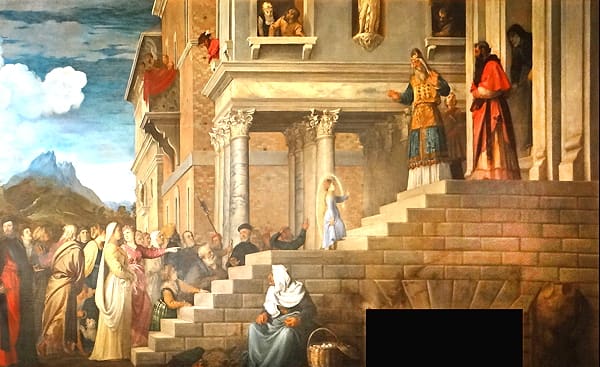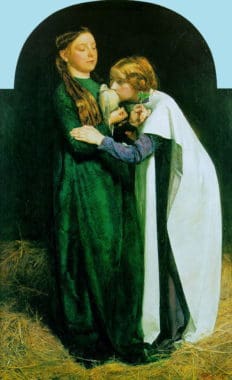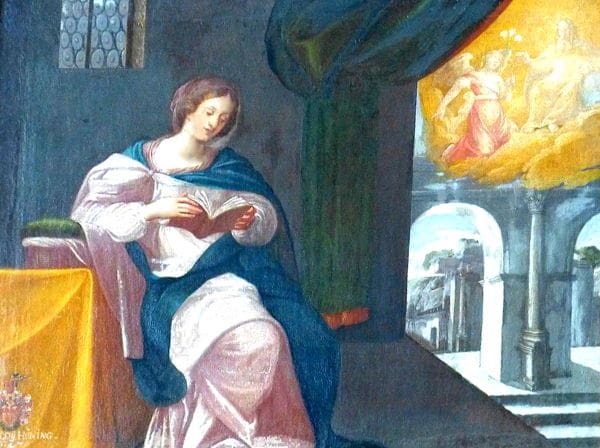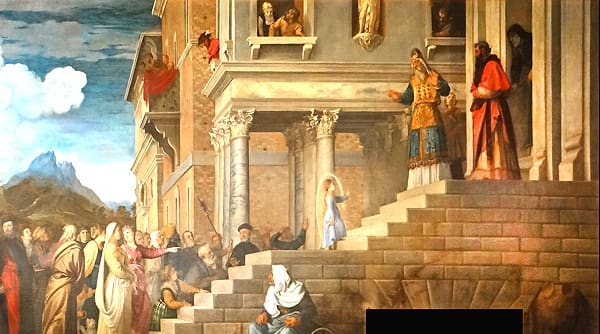The Presentation of Mary in the Temple
Part II

Editor’s Note: For today’s memorial last year, we shared with you the first part of this reflection, which can be read by clicking here. Today we continue Saint Alphonsus Liguori’s presentation from his work “The Glories of Mary”.
When the holy company had arrived at the temple, the eager child turned to her parents, kneeling kissed their hands, and asked for their benediction; and then, without turning back, she ascended the fifteen steps of the temple, as Arias Montanus relates upon the authority of Josephus, the Jewish historian, and presented herself to the priest, who, according to St. Germanus, was Zachary; then, taking leave of the world, and renouncing all the goods which it promises to its followers, she offered and consecrated herself to her Creator.
 At the time of the deluge, the raven which was sent by Noah from the ark remained to feed upon the bodies of the dead, but the dove without stopping to rest her foot, returned quickly to the ark. She returned to him into the ark: “Reversa est ad eum in arcam” (cf Genesis 8:9). Many who are sent by God into this world, unhappily stop to feed on earthly things. Not so Mary, our celestial dove; she knew that God should be our only good, our only hope, our only love; she knew that the world is full of dangers, and that he who the soonest leaves it, is freest from its snares; therefore she sought promptly to flee from it in her tenderest years, and seclude herself in the sacred retirement of the temple, where she could better hear the voice of God, and better honor and love him. And thus the holy Virgin, from the beginning of her life, rendered herself dear and acceptable to her Lord, as the holy Church makes her say: Rejoice with me, all ye who love the Lord, for when I was little I pleased the Most High [from the Fourth Responsory of the Fourth Lesson from New Year’s Day, old Roman Breviary]. For this reason, she was compared to the moon; for as the moon completes her course more quickly than the other planets, so Mary attained perfection sooner than all the saints, by giving herself promptly to God without delay; and entirely without reserve. And now let us pass to the second point, upon which we shall have much to say.
At the time of the deluge, the raven which was sent by Noah from the ark remained to feed upon the bodies of the dead, but the dove without stopping to rest her foot, returned quickly to the ark. She returned to him into the ark: “Reversa est ad eum in arcam” (cf Genesis 8:9). Many who are sent by God into this world, unhappily stop to feed on earthly things. Not so Mary, our celestial dove; she knew that God should be our only good, our only hope, our only love; she knew that the world is full of dangers, and that he who the soonest leaves it, is freest from its snares; therefore she sought promptly to flee from it in her tenderest years, and seclude herself in the sacred retirement of the temple, where she could better hear the voice of God, and better honor and love him. And thus the holy Virgin, from the beginning of her life, rendered herself dear and acceptable to her Lord, as the holy Church makes her say: Rejoice with me, all ye who love the Lord, for when I was little I pleased the Most High [from the Fourth Responsory of the Fourth Lesson from New Year’s Day, old Roman Breviary]. For this reason, she was compared to the moon; for as the moon completes her course more quickly than the other planets, so Mary attained perfection sooner than all the saints, by giving herself promptly to God without delay; and entirely without reserve. And now let us pass to the second point, upon which we shall have much to say.
Point Second – The enlightened infant well knew that God does not accept a divided heart, but wishes it entirely consecrated to his love, according to the precept he has given:
“Thou shalt love the Lord thy God with thy whole heart.”
Hence, from the first moment of her existence, she began to love God with all her strength and gave herself wholly to him. But her most holy soul awaited with earnest desire the time when she could, in reality, consecrate herself entirely, and with a public solemnity, to God. Let us consider, then, with how great a fervor the loving Virgin, seeing herself actually inclosed in that holy place, first prostrated herself to kiss that ground as the house of the Lord, then adored his infinite majesty, and thanked him for the favor she had received of being brought so early to inhabit his house. Then she offered herself entirely to God; entirely, without reserving anything. She offered to him all her powers and all her senses, her whole mind and her whole heart, her whole soul and her whole body, for it was then, as we are told, that to please God, she made the vow of virginity. A vow, according to Rupert the Abbot, that Mary was the first to make: “Votum virginitatis prima emisit.” And she offered herself without limitation of time, as Bernardine de Bustis asserts: Mary offered and dedicated herself to the perpetual service of God. Since she had then the intention of dedicating her whole life to the service of his Divine Majesty in the temple, if it should so please God, and of never quitting that sacred place, Oh, with what affection must she have exclaimed: My beloved to me, and I to him: “Dilectus metis mihi, et ego illi” (cf Song of Songs 2:16a). I for him, as Cardinal Hugo remarks, will wholly live and will wholly die: “Ego illi tota vivam, et tota moriar.” My Lord and my God, she said, I have come hither only to please thee, and to give thee all the honor I can; here I will live wholly for thee and die for thee, if it so please thee; accept the sacrifice which this thy poor servant makes to thee, and help me to be faithful to thee.
And here let us consider how holy was the life that Mary led in the temple, where, like the rising morn, “Quasi aurora consurgens”; increasing always in perfection, as the dawn increases in light; who can describe how, from day to day, in  her more brightly shone her virtues; charity, modesty, humility, silence, mortification, meekness? This fair olive tree, planted in the house of God, as St. John Damascene says, under the inspiration of the Holy Spirit, became the habitation of all the virtues. The same saint says in another place: The countenance of the Virgin was modest, her mind humble, her words kind, proceeding from a recollected heart. And he elsewhere asserts: The Virgin withdrew her thoughts from all earthly things, embracing all the virtues. Thus, then, by the practice of perfection, she made so great progress in a short time, as to merit being made a temple worthy of God.
her more brightly shone her virtues; charity, modesty, humility, silence, mortification, meekness? This fair olive tree, planted in the house of God, as St. John Damascene says, under the inspiration of the Holy Spirit, became the habitation of all the virtues. The same saint says in another place: The countenance of the Virgin was modest, her mind humble, her words kind, proceeding from a recollected heart. And he elsewhere asserts: The Virgin withdrew her thoughts from all earthly things, embracing all the virtues. Thus, then, by the practice of perfection, she made so great progress in a short time, as to merit being made a temple worthy of God.
Editor’s Note: The final part of this series (part III), may be read by clicking here.
+
Art: Modified detail of Presentation of Virgin Mary, Titian, from 1534-1538, CCA-SA 2.0 Generic; The Return of the Dove to the Ark, John Everett Millais, 1851, PD-US author’s life plus 100 years or less; modified detail of Reading Virgin Mary in the Temple, artist unidentified, 1647, photographed by Wolfgang Sauber, 23 August 2016, CCA-SA 4.0 International; all Wikimedia Commons.




